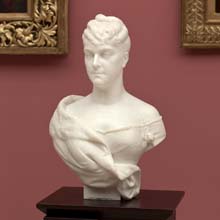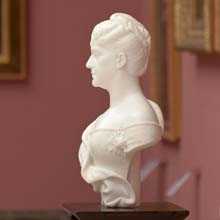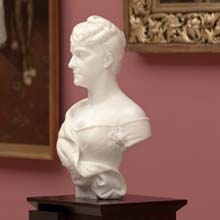


material: marble
dimensions: 68 × 44,5 × 32 cm
description: The academic bust by Pius Weloński, carved in Carrara marble, depicts Dolores Radziwiłł (1886–1966), or actually – Dolores Konstancja Joanna Radziwiłł – daughter of Dominik Radziwiłł, the owner of an estate in Balice near Krakow, and the Spaniard Dolores de Agramonte. Her first husband, the adjutant to Józef Piłsudski, Stanisław Wilhelm Radziwiłł, whom she married at the age of 20, was killed after 14 years of their marriage, in 1920, during the April offensive in Ukraine. A year later, Dolores married her cousin Leon Konstanty Radziwiłł “Loche,” who took an active part in the artistic life of Paris. Dolores, who was sensitive to art, had desired to go there for a long time. The second marriage was extremely successful, though it ended up tragically. Stanisław, who did not deny himself drugs, died in 1932 in mysterious circumstances. Nonetheless, this relationship brought a positive change in the life of the Polish aristocrat. Her bosom friend, Misia Godebska-Sert, an interesting figure of the artistic bohemia of inter-war Paris, wrote about it in her memoirs. This patroness of many artists, a close friend of Picasso, Bonnard and others, regarded Dolores as the “most amusing woman.” According to her, every crazy thing seemed something natural and normal when done with Dolores. With time, Dolores Radziwiłł became an important figure in Misia’s “retinue.” Together they carried out even the most eccentric ideas like, for example, helping young artists from Krakow organize a ball in Salle d’Horticulture at rue de Grenelle in Paris. Allegedly, the ball, which went down in history as the Kapists’ “Super Jazz Ball,” was held under the honorary patronage of Dolores in conjunction with Picasso. Dominik Kuryłek
exposition: The Gallery of 19th Century Polish Art in Sukiennice,
The Cloth Hall, 1, Main Market Square
key: Around the academy <<<
Paintings and sculptures on display in the room called “Around the Academy” were produced by artists influenced by the standards of art taught at the academies of fine arts and shown at official exhibitions, that is academic art which usually appealed to the tastes and interests of the elites and the more affluent part of the society.
In the 19th century, European painting was under the influence of academies which implanted in students the universally accepted standards of artistic creation, established already in the 17th century by the Royal Academy of Painting and Sculpture in Paris. According to these principles, art gives real shape to ideal beauty and expresses noble subjects taken from the Holy Scripture, mythology, literature and history, to be depicted as a tale, or history. As a result, in the academic hierarchy of genres, history painting was regarded as the highest form of painting, because while painting a story, an artist had an opportunity to show off his erudition based on the literary text. Slightly lower in the hierarchy were landscape painting, portraiture and genre painting, and still life was placed at the bottom. Some artists defied those principles, which led to the emergence of new trends towards the end of the century – Realism and Impressionism.
In general, the term “academism” in the 19th-century art refers to paintings and sculptures characterised by the sublime content and precision of the finish, known as fini. In the second half of the 19th century, when the artistic value of the sketch began to be appreciated and the representation of idealized subjects was gradually supplanted by realism, not all academicians followed the above standards. Constant changes which the term ‘academician’ and the principles of academic painting were subject to in the 19th century were the reason to call this part of the exhibition “Around the Academy.”
Painting illustrating historical themes changed considerably in the 19th century. Along with the development of archaeological and historical research, the knowledge of the realities the old days increased. The public demanded more and more of the erudite artist: not only did he have to familiarize himself with a literary text and depict it in the painting, but he was also expected to verify written and pictorial historical sources to illustrate past events accurately and objectively. While in the first half of the 19th century literary subjects were still dominant in Polish history painting, in the latter half of the century it was more common to illustrate themes taken from historical sources (e.g. Prussian Homage by Jan Matejko, Battle of Cecora by Witold Piwnicki). It was Jan Matejko who took a special place in Polish history painting, often being considered as the founder of this movement. What is extraordinary about his fame is that his works, satisfying the Poles’ desire to see the full glory of the nation’s past, were, and still are, admired by the whole nation.
Ancient times, most beautifully illustrated in the canvases of Henryk Siemiradzki and sculptures of Pius Weloński, served as an important subject. In the 19th century, it was believed that the fate of the persecuted Christians and Slavic gladiators bore some resemblance to the situation of the oppressed Poles, suggesting that the nation, like the ancient heroes, also had a chance to free themselves from the yoke of bondage.
The work by Feliks Cichocki-Nałęcz Mother of God as a Spinner, which combines a “modernized” image of Mother of God, shown during everyday work, with a traditional, in terms of technique and composition, way of painting, typical of the academic art of the second half of the 19th century, is an example of a novelty in academic religious painting.
Visits of Europeans to Africa and Asia aroused Polish artists’ interest in oriental motifs. Their works depicted uncomplicated genre scenes, clothes and objects typical of the general impressions of a tourist going to exotic countries (e.g. By the Well by Tadeusz Ajdukiewicz). The Polish public was more likely to accept and appreciate genre scenes if they contained some patriotic allusions and referred to national tradition or history (The Zwierzyniec Hobby Horse by Hipolit Lipiński).
Despite the discovery of photography, painted portraits retained their popularity and were still watched and valued not only by critics and exhibition audiences, but also people who ordered such works. This painting genre is shown on the example of official portraits painted by Jan Matejko, Henryk Rodakowski, Kazimierz Pochwalski and Pius Weloński.
Barbara Ciciora
dimensions: 68 × 44,5 × 32 cm
description: The academic bust by Pius Weloński, carved in Carrara marble, depicts Dolores Radziwiłł (1886–1966), or actually – Dolores Konstancja Joanna Radziwiłł – daughter of Dominik Radziwiłł, the owner of an estate in Balice near Krakow, and the Spaniard Dolores de Agramonte. Her first husband, the adjutant to Józef Piłsudski, Stanisław Wilhelm Radziwiłł, whom she married at the age of 20, was killed after 14 years of their marriage, in 1920, during the April offensive in Ukraine. A year later, Dolores married her cousin Leon Konstanty Radziwiłł “Loche,” who took an active part in the artistic life of Paris. Dolores, who was sensitive to art, had desired to go there for a long time. The second marriage was extremely successful, though it ended up tragically. Stanisław, who did not deny himself drugs, died in 1932 in mysterious circumstances. Nonetheless, this relationship brought a positive change in the life of the Polish aristocrat. Her bosom friend, Misia Godebska-Sert, an interesting figure of the artistic bohemia of inter-war Paris, wrote about it in her memoirs. This patroness of many artists, a close friend of Picasso, Bonnard and others, regarded Dolores as the “most amusing woman.” According to her, every crazy thing seemed something natural and normal when done with Dolores. With time, Dolores Radziwiłł became an important figure in Misia’s “retinue.” Together they carried out even the most eccentric ideas like, for example, helping young artists from Krakow organize a ball in Salle d’Horticulture at rue de Grenelle in Paris. Allegedly, the ball, which went down in history as the Kapists’ “Super Jazz Ball,” was held under the honorary patronage of Dolores in conjunction with Picasso. Dominik Kuryłek
exposition: The Gallery of 19th Century Polish Art in Sukiennice,
The Cloth Hall, 1, Main Market Square
key: Around the academy <<<
Paintings and sculptures on display in the room called “Around the Academy” were produced by artists influenced by the standards of art taught at the academies of fine arts and shown at official exhibitions, that is academic art which usually appealed to the tastes and interests of the elites and the more affluent part of the society.
In the 19th century, European painting was under the influence of academies which implanted in students the universally accepted standards of artistic creation, established already in the 17th century by the Royal Academy of Painting and Sculpture in Paris. According to these principles, art gives real shape to ideal beauty and expresses noble subjects taken from the Holy Scripture, mythology, literature and history, to be depicted as a tale, or history. As a result, in the academic hierarchy of genres, history painting was regarded as the highest form of painting, because while painting a story, an artist had an opportunity to show off his erudition based on the literary text. Slightly lower in the hierarchy were landscape painting, portraiture and genre painting, and still life was placed at the bottom. Some artists defied those principles, which led to the emergence of new trends towards the end of the century – Realism and Impressionism.
In general, the term “academism” in the 19th-century art refers to paintings and sculptures characterised by the sublime content and precision of the finish, known as fini. In the second half of the 19th century, when the artistic value of the sketch began to be appreciated and the representation of idealized subjects was gradually supplanted by realism, not all academicians followed the above standards. Constant changes which the term ‘academician’ and the principles of academic painting were subject to in the 19th century were the reason to call this part of the exhibition “Around the Academy.”
Painting illustrating historical themes changed considerably in the 19th century. Along with the development of archaeological and historical research, the knowledge of the realities the old days increased. The public demanded more and more of the erudite artist: not only did he have to familiarize himself with a literary text and depict it in the painting, but he was also expected to verify written and pictorial historical sources to illustrate past events accurately and objectively. While in the first half of the 19th century literary subjects were still dominant in Polish history painting, in the latter half of the century it was more common to illustrate themes taken from historical sources (e.g. Prussian Homage by Jan Matejko, Battle of Cecora by Witold Piwnicki). It was Jan Matejko who took a special place in Polish history painting, often being considered as the founder of this movement. What is extraordinary about his fame is that his works, satisfying the Poles’ desire to see the full glory of the nation’s past, were, and still are, admired by the whole nation.
Ancient times, most beautifully illustrated in the canvases of Henryk Siemiradzki and sculptures of Pius Weloński, served as an important subject. In the 19th century, it was believed that the fate of the persecuted Christians and Slavic gladiators bore some resemblance to the situation of the oppressed Poles, suggesting that the nation, like the ancient heroes, also had a chance to free themselves from the yoke of bondage.
The work by Feliks Cichocki-Nałęcz Mother of God as a Spinner, which combines a “modernized” image of Mother of God, shown during everyday work, with a traditional, in terms of technique and composition, way of painting, typical of the academic art of the second half of the 19th century, is an example of a novelty in academic religious painting.
Visits of Europeans to Africa and Asia aroused Polish artists’ interest in oriental motifs. Their works depicted uncomplicated genre scenes, clothes and objects typical of the general impressions of a tourist going to exotic countries (e.g. By the Well by Tadeusz Ajdukiewicz). The Polish public was more likely to accept and appreciate genre scenes if they contained some patriotic allusions and referred to national tradition or history (The Zwierzyniec Hobby Horse by Hipolit Lipiński).
Despite the discovery of photography, painted portraits retained their popularity and were still watched and valued not only by critics and exhibition audiences, but also people who ordered such works. This painting genre is shown on the example of official portraits painted by Jan Matejko, Henryk Rodakowski, Kazimierz Pochwalski and Pius Weloński.
Barbara Ciciora












